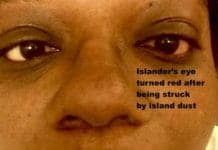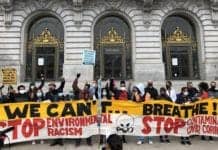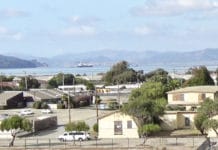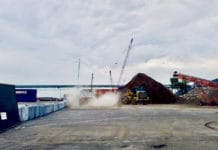by Carol Harvey
On Wednesday, Sept. 10, 2014, in Room 400, City Hall, a Treasure Island Development Authority (TIDA) board member asked whether current residents are protected from earthquakes, tsunamis, liquefaction, sinking and sea level rise.
Bob Beck, Treasure Island Development Corp. director, explained that an earthquake won’t prevent the 2,000 residents, including 500 children, housed on the northwestern end of the man-made island from walking the mile across liquefying, moving, shaking silt to a frail, antiquated hangar built in 1939 for the Golden Gate International Exposition at the southeastern perimeter near Clipper Cove.
No disaster plan for Treasure Island: Bob Beck, Treasure Island Redevelopment coordinator, tells Treasure Island Board member Mark Dunlop that in an earthquake island residents will be housed at Building 1, an antiquated airplane hangar built in the 1930s and that they are still doing “outreach” to the community. Kathryn Lundgren, resident, suggests a safe place from which islanders can be removed in safety. She thinks island officials will use Hangar 3, thereby identifying a serious communication glitch between island officials and residents which could make a life or death difference in an island disaster.
A team of architects and geo-engineers had just described extensive and elaborate redevelopment plans they drafted to protect the new, wealthy Treasure Island condominium residents from similar disasters.
Aging, failing infrastructure

Andrea McHenry, reluctant Treasure Island renter who fears she is in danger, pointed out what all islanders know. Aside from complete lack of earthquake and tsunami protections, “Water, electrical and gas infrastructure out here is more than 70 years old. It was only meant to last 30.”
Common wisdom holds that Island authorities have simply abandoned the buildings and infrastructure to crumble until they are razed during the redevelopment build-out phase, which will not start until 2015 and could last over a decade. In the process, they seem also to have abandoned the low-income people they enticed to the island, who are providing rent and securing the infrastructure until the island can be rebuilt for rich condo owners.
Big sewage spill
In June 2014, the island’s “Next Door” listserv members recorded a large sewage spill. An islander showed me a drain in a grassy path below her house from which sewage had bubbled. While island officials scrambled to identify the housing provider responsible for drain-cleaning at that location, for over a month noxious odors sickened nearby neighbors and kids ran down a path saturated with fecal matter. Four months later, toilet paper clumps remain snagged in the grass around the drain cover.
NERT and the poisoned water
Only once in San Francisco history – when a water main broke on Treasure Island – was the Neighborhood Emergency Response Team (NERT) activated. For up to and beyond 24 hours after the pipes actually burst, Andrea reports, “our water was tainted. The water pipes were compromised for 24 hours before NERT was activated to begin circulating warning fliers by hand-posting them on our front doors.”
For an entire day, Andrea and all her neighbors cooked, drank, showered and brushed their teeth with the water.
“Who knows how long that water main was leaking, and what was leaking into it (from) whatever is in the soil. The day that NERT was activated out here, I was too sick to participate. I had one of the worst sick headaches I’d ever had in my life, and I couldn’t get out of bed.”
Electrical and gas – fire danger
Faulty electrical infrastructure creates ongoing fire danger. “The fire that burned here (on Mariner Drive) and killed a 10-year-old girl” traumatized friends who knew her. Sobbing bystanders heard cries inside the house that simply stopped.
Frequent power outages
Power outages create costly appliance wear and tear. When power is restored, electricity surges and “everything that’s plugged in gets worn out and damaged just a little more than if you lived somewhere else,” she stated. Though she resents the time wasted, her justified hyper-vigilance anticipating the next outage forces Andrea to unplug anything of value every time she leaves home. “This is one of the many hidden costs of living on Treasure Island,” said Andrea ruefully.
When PG&E installed the wrong transformer on a telephone pole behind her house, the company blew out electrical equipment in about half a dozen rows of townhouses, affecting about 35 units. Andrea’s appliances valued at $3,000 were destroyed. “A lot of us lost thousands of dollars worth of appliances. We got hardly anything back.
“The way it works is, if you roll a brand new Mercedes Benz off the lot and get into an accident, even with good insurance you receive nowhere near the value of what you paid,” she said.
Navy and RAB board double talk and contradictions
At Restoration Advisory Board meetings, the Navy constantly reassures residents the island is safe; they are cleaning radiation to “safe” levels. Simultaneously, RAB member Dale Smith describes seismic instability and liquefaction.
The RAB welcomes the public to meetings, offering email updates, a monthly slick, full-color glossy newsletter, enormous polychromatic charts on easels, cookies and an agenda. They repeat, “We want more residents to come. We want your input.”
“At meetings, their underlying message to those of us who are leery is, ‘If you don’t know that it’s safe to live here, it’s because YOU’RE not a scientist’ and ‘You couldn’t POSSIBLY understand all the things we know,’” said Andrea.

Seismic instability and liquefaction
Conversely, after Mirian Saez became the newly appointed island director, she announced at an introductory community meeting it would take at least 10 years from the moment they began shoring up the island to make it seismically sound. They haven’t yet begun.
The architects and engineers at the Sept. 10 TIDA meeting told Board members their extensive redevelopment plans include stabilizing the sand and gooey mud beneath it by employing drill devices to pound water out of these two highly unstable soil types. Where one end of the island has sunk several feet, they will shore it up and erect buildings on the flattened, dehydrated mud and sand. Because they don’t expect Bay waters to rise high enough to endanger the island, they will delay sea level rise stratagems until century’s end.
“The island is not a bowl of dry rocks and soil,” said Andrea. “This is water with rocks and soil poured on top of it.”
A pipefitter friend of Andrea’s, a San Francisco native, described original island construction. The people who built the artificial island poured landfill into a ring of rocks they left full of water. He told her, ‘It’s not like solid landfill; it’s a bowl of jello.’ “It’s liquid,” she said. “If you dig around this area where I live, two to four feet down you’ll find water.
“I saw a demonstration on TV,” she said. “Take a bowl, fill it with sand, and make a little mountain in the middle. Then pour water in the bowl so there’s a little moat around the sand mountain. Jiggle the bowl. See what happens. The sand melts into the water.”
In a 15-second earthquake, Treasure Island residents will be no safer than Marina residents in 1989. The reason is liquefaction. “This is a red zone,” she said. “We’re not safe here. I can’t get a straight answer as to whether or not our homes are bolted to their foundations.”

Andrea reprised RAB member Dale Smith’s observation: “‘When we have a big earthquake here – 7-point something or higher – because it is liquefaction material, significant areas of this island will boil, split and spread. Up to 500 feet of shoreline around Treasure Island will spread into the Bay.’”
Tsunami danger
Andrea recently attended a Neighborhood Emergency Response Training (NERT) tsunami workshop in a San Francisco auditorium.
“I took copious notes and have all the handouts. Among other tsunami facts, the presenters covered what will happen if we have either a large, local earthquake or a large distant earthquake.”
Two expert geologists who study tsunamis for a living did “all this mapping and predicting” of hypothetical scenarios.
According to the experts, the two scenarios most likely to cause a tsunami in San Francisco are a large, local earthquake lasting 60 seconds or more on one of the faults running under (the Bay Area). … Or a stupendously large earthquake” in Alaska.
The geologists said that just the right kind of earthquake – say, an 8.0 in Alaska – in just the right place, could trigger a 20-25 foot tsunami wave. As the wave rides under the Golden Gate Bridge, it will be reduced to just 9 feet. That would wipe out Alameda.
If a large Alaska earthquake generates a tsunami, we will have about five hours before the wave glides under the Golden Gate and slams into San Francisco.
Officials need about an hour to get their act together, disseminate announcements and start evacuations. ‘You have about four hours to get out of the tsunami zone,’ they said.
“What about Treasure Island?” Andrea asked. “The geologists admitted that they hadn’t thought about Treasure Island. Where’s that? Oh, yeah! You’ll be inundated. Treasure Island will be gone.’”
Andrea noted that the ‘89 earthquake lasted 15 seconds. An earthquake close to a minute, four times longer, depending on which fault it was on, will probably trigger a tsunami. And because Treasure Island is surrounded by water, the tsunami could come from any direction.
Man-made causeway on stilts would crumble
In coastal areas like San Francisco and Alameda, if there’s a large, local earthquake, you don’t have four or five hours; you have 10 minutes to move to higher ground from the tsunami zone.
Treasure Islanders must walk to escape earthquakes: Bob Beck, Treasure Island Redevelopment coordinator, tells Treasure Island board member Mark Dunlop that in an earthquake, island residents must walk a mile to safety.
Two barriers prevent escaping Treasure Island. In addition to a crumbled Bay Bridge, the long, narrow man-made causeway road between Yerba Buena and Treasure Island was constructed as highly vulnerable scaffolding elevated on stilts.
Post-earthquake, with the bridge down and the causeway out, Treasure Islanders could be trapped on a splitting, bubbling, sinking pile of mud. The buildings could jump off their foundations, and a tsunami could come from any direction.
If Bob Beck’s scenario were realized, Andrea the swimmer, knows that, as they pick their way across the fragile island to the old 1939 airplane hangar, all 2,000 Treasure Island inhabitants could easily be sucked into the dark and chilly waters of San Francisco Bay.
Carol Harvey is a San Francisco political journalist specializing in human rights and civil rights. She can be reached at carolharvey1111@gmail.com.

 Store
Store












